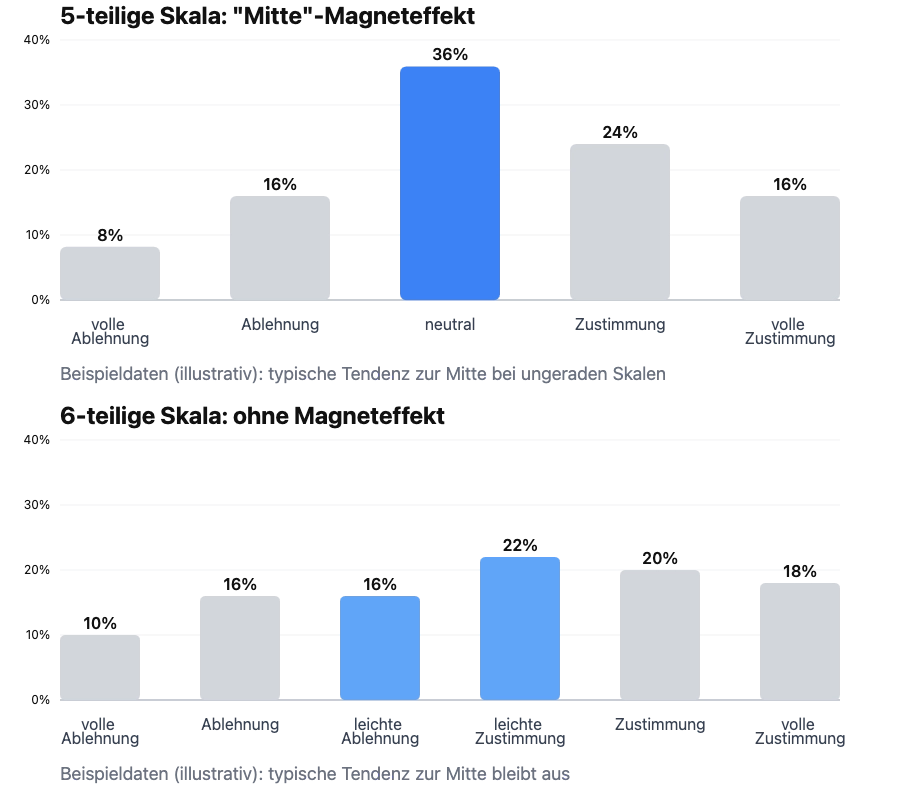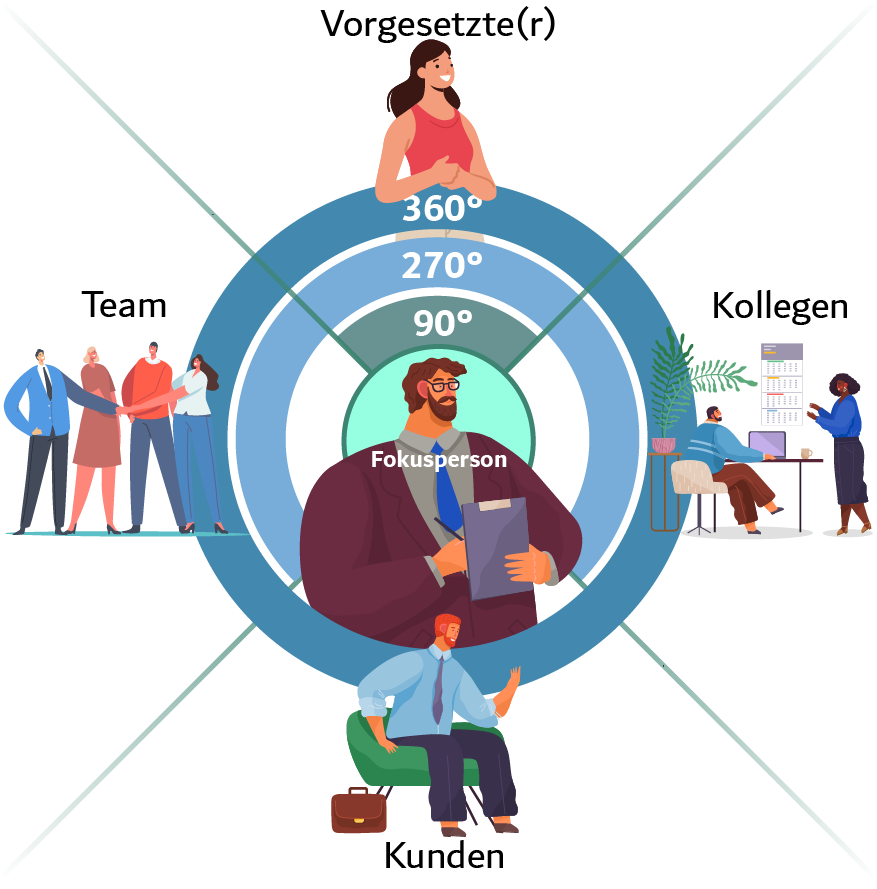Why feedback is strategically essential today
Feedback as a strategic resource
Just a few decades ago, it was considered sufficient to give employees feedback once a year as part of an employee interview. Today, the situation has fundamentally changed: Global competition, a shortage of skilled workers, hybrid working environments and increasing customer expectations have rewritten the rules of the game. Companies must be faster, more flexible and more able to learn than ever before.
In this context, feedback becomes a strategic resource. Feedback from employees and customers provides decisive information on how effective an organization really is — and where action is needed. The sentence “Feedback is the new currency in companies” (Münster, 2018) puts it in a nutshell: If you ignore feedback, you forego valuable capital.
The relevance of feedback is well proven scientifically. Studies show that companies with a distinctive feedback culture have higher innovative capacity, stronger employee loyalty and increased customer satisfaction (Ju et al., 2021). Conversely, ignoring feedback often leads to frustration, fluctuation, and an erosion of trust (Englert, 2018).
From feedback to actionable data
But feedback is not always feedback. While many organizations certainly carry out employee surveys or customer surveys, the benefits often fall short of expectations. Such initiatives often end with a report that disappears into a drawer. The result: disappointment on the part of respondents and “survey fatigue” — a declining willingness to participate in surveys at all.
Die organizational psychology has long pointed out that feedback is only effective when it is in concrete actions is transferred (Ilgen, Fisher & Taylor, 1979). Otherwise, the process is perceived as a symbolic policy, which can even undermine trust and motivation (Hübner & Zacher, 2021).
It is precisely at this point that the EUCUSA method to: She turns feedback into Cycle of change, which systematically links data, dialogue and measures.
What is the EUCUSA method?
The EUCUSA method was developed in 1997 in cooperation with the Fraunhofer Society. From the outset, the goal was To design feedback processes in such a way that they not only collect data, but also trigger real change.
The special thing about the EUCUSA method:
- It is systemically — Feedback is not considered in isolation, but in the context of organization, culture and strategy.
- It is tailored — Questionnaires are individually adapted instead of putting standard questions about each organization.
- It is scientifically based — psychometric tests ensure validity and reliability.
This makes the EUCUSA method significantly different from traditional standard surveys, which often only provide sentiment images without being embedded in change processes.
Peter Senge (1996) described organizations that develop through continuous feedback and learning as “learning organizations.” It is precisely in this spirit that the EUCUSA method is anchored: Feedback becomes the engine of organizational learning processes — both internally (via employee surveys) and externally (via customer surveys).
Employee survey and customer survey as core elements
In essence, the EUCUSA method is based on the conviction that Employee satisfaction and customer satisfaction are two sides of the same coin. Numerous studies have shown that engaged and satisfied employees perform better, which in turn leads to happier customers (Heskett et al., 1994; Loveman, 1998).
- employee surveys provide data on motivation, retention, leadership experience and working conditions.
- customer surveys reflect service quality, loyalty and market expectations.
- Together, they provide a complete picture, which makes interactions visible.
For example, organizations can recognize that departments with a high level of employee satisfaction also achieve better customer reviews — a strong argument for investing in personnel and organizational development.
Why a new approach is needed
Why do companies today need a methodology like the one from EUCUSA? The reason is that traditional surveys often suffer from three weaknesses:
- Standardization without relevance: Ready-made questionnaires rarely fit an organization's specific culture and strategy.
- Lack of implementation: Results are reported but not translated into measures.
- Lack of credibility: Employees and customers lose trust if feedback has no consequences.
The EUCUSA method addresses precisely these weaknesses. It combines individual adjustment, respectful communication And one clearly structured follow-up process. This makes it a tool that not only provides data, but actually gets organizations moving.
Scientific basis: Why methodology is crucial
When organizations opt for a employee survey or customer survey Decide, a central question immediately arises: How valid and reliable is the data? Because only if the results meet scientific standards can managers make strategic decisions on this basis.
From the outset, the EUCUSA method was based on the Quality criteria of empirical social research oriented:
- Validity — does the survey really measure what it is supposed to measure (e.g. satisfaction, commitment, loyalty)?
- Reliability — Are the results stable and consistent when repeated?
- objectivity — Is it ensured that results are independent of the person who evaluates the survey?
This scientific rigour is a key differentiator. While standard surveys often only collect superficial impressions, the EUCUSA method provides a sound basis that managers can take seriously (Bortz & Döring, 2006).
Tailored questionnaires instead of standard solutions
A core principle of the EUCUSA method is development individual questionnaires. Each questionnaire is developed together with the organization and takes into account its strategy, culture and language. At the same time, there is a standardized core, which enables comparisons within and between companies.
example:
- In an employee survey, the dimensions could Management, Collaboration, Communication, Recognition, Working Conditions be included.
- In a customer survey, it would be something like service quality, product quality, value for money, image, complaint management.
This combination of Individualization and standardization enables both tailor-made statements and benchmarking. This makes scientific sense, as comparative data is only generated by a stable core, while individualization ensures relevance and acceptance (Hackman & Oldham, 1975; Parasuraman et al., 1988).
The 6-point scale: Decisions instead of evasive behavior
A methodological feature is the use of a 6-level scale. Why six steps and not five?
- Not a neutral center: A 5-point scale offers a “safe middle” that respondents often choose so as not to have to commit themselves. The 6-point scale, on the other hand, forces a decision to be made: approval or rather rejection.
- Higher differentiation: Studies show that even odd scales without a middle category provide more differentiated and meaningful results (Krosnick & Presser, 2010).
- More informative value for decisions: As a result, companies receive sharper data that is less diluted by neutral answers.

For organizations, this means: A 6-point scale delivers clearer signalswhere measures are necessary.
Positively formulated questions: psychology of language
Another key feature of the EUCUSA method is the consistently positive formulation of all questions. That sounds like a linguistic detail, but it has profound psychological effects:
- Easier to understand: Positively formulated statements are cognitively easier to process, which reduces misunderstandings (Podsakoff et al., 2003).
- Solution orientation: Anyone who evaluates a positive statement automatically thinks more in terms of development opportunities rather than deficiencies (Seligman, 2011).
- Promoting psychological safety: Discussions about the results create a constructive framework in which employees speak more openly (Edmondson, 1999).
An example:
- In negative terms: “My manager is not giving me enough information. ”
- In positive terms: “My manager ensures that I receive the necessary information. ”
The second variant invites a constructive discussion about improvements, while the first one easily triggers defensive attitudes.
Anonymity and trust as a basis
One of the most decisive factors for the success of surveys is anonymity. Only when employees and customers are sure that their answers will be kept confidential, will they provide honest feedback.
Research shows that perceived anonymity massively increases willingness to participate and answer (Singer & Presser, 2007). In practice, this often results in response rates that are well above the industry average.
For managers, this means that anonymity is not just a data protection issue, but a strategic success factor for the quality of employee surveys and customer surveys.
Priority portfolio: From data to fields of action
Another methodological innovation is the so-called Action portfolio. Here are results relating to their importance analysed:
- areas with high importance and low rating = urgent need for action.
- areas with high importance and high rating = Strengths that need to be expanded.
- areas with low importance may be treated as secondary.
This approach is based on the Importance performance analysis from market research (Martilla & James, 1977) and helps organizations to use their resources in a targeted manner.

Combining quantitative and qualitative data
While standardized scale values provide a solid basis for statistical analyses, the EUCUSA method is also based on qualitative comments. Free text fields enable employees and customers to provide context and concrete suggestions for improvement.
Empirical research shows that such comments often contain decisive clues as to why certain assessments come about (Nishii et al., 2008). For managers, they are therefore a valuable key to understanding quantitative data.
From data to change: The core of the feedback process
Feedback processes only have their full effect if they are more than just collections of data. One employee survey or customer survey, which ends in a PDF report, remains a paper tiger. Studies clearly show: Only when the results in concrete measures are transferred, there are improvements in commitment, retention and performance (Hübner & Zacher, 2021).
The EUCUSA method starts right here. It sees feedback not as an end point, but as Starting point a development cycle:
- levying — structured survey of employees or customers.
- analysis — Evaluation of data, identification of strengths and areas of action.
- dialogue — Workshops in which results are transparently communicated and discussed.
- measures — participatory development of concrete changes.
- Follow-up — Review of effectiveness in the next survey.

Feedback strengthens self-efficacy and willingness to learn
Scientific research underlines that feedback is a crucial lever for individual and organizational development.
- Self-Efficacy: Feedback strengthens employees' belief that they can make a difference through their own actions. It is precisely this conviction that is a central predictor of willingness to learn and perform (Maurer et al., 2003).
- willingness to learn: A recent study by Genkova & Gassel (2024) shows that feedback from supervisors and colleagues significantly increases the willingness to learn — particularly through increased self-effectiveness.
- Organizational learning: Ju et al. (2021) were able to prove in a meta-analysis that a distinctive feedback and learning culture is associated with higher job satisfaction, stronger retention and lower intent to fluctuate.
In other words: Feedback is not a “soft skill,” but a hard resource that is directly linked to performance and retention.
Employee survey as a management tool
employee surveys have long been more than just an HR tool for polling sentiment. When implemented correctly, they become a strategic management tool.
- They cover blind spots in leadership, communication and collaboration.
- They provide clues to Early indicators of fluctuation, such as declining satisfaction with career opportunities.
- They measure psychological safety — in other words, the confidence to be able to express critical opinions (Edmondson, 1999).
Research also shows that employee surveys are particularly effective when employees in the Follow-up process be included. A study by Nielsen & Randall (2012) highlights that participation in the development of measures is crucial to ensure acceptance and effectiveness.
Customer survey as a strategic success factor
While employee surveys shed light on the internal perspective, offer customer surveys the view from outside. In an increasingly saturated market environment, customer satisfaction is a decisive competitive factor.
- Customer satisfaction and loyalty are strong drivers for repurchases, cross-selling and positive word of mouth (Anderson, Fornell & Lehmann, 1994; Reichheld, 2003).
- Service quality feedback helps uncover gaps between expectation and performance (Parasuraman, Zeithaml & Berry, 1988).
- Continuous customer feedback makes it possible to identify trends at an early stage and proactively adapt products or services.
The EUCUSA method integrates customer surveys into the same systemic cycle as employee surveys. This is how a holistic picture: Satisfied employees contribute to better customer experiences, and positive customer experiences in turn strengthen employee motivation.
Feedback culture as a basis for trust
A central concept is Feedback culture — i.e. an organization's attitude towards how open and appreciative feedback is given, received and implemented.
- Positive feedback culture: It promotes trust, job satisfaction and retention. Employees feel taken seriously and develop a higher level of identification with the organization (Richardson & Vandenberg, 2005).
- Negative feedback culture: If feedback is ignored or treated without consequences, employees experience this as a symbolic policy. This can destroy trust and increase the tendency to fluctuate (Englert, 2018).
The EUCUSA method acts as a catalyst here: It not only provides data, but also designs the entire process in such a way that feedback is experienced in a credible, appreciative and action-oriented way.
Risks of missing follow-ups
One of the biggest risks of employee and customer surveys is that absence of consequences. Hübner & Zacher (2021) warn in their systematic review that surveys are perceived as “empty rituals” without follow-up activities. Church & Oliver (2006) showed empirically that departments that introduced concrete improvements following surveys had significantly better results in turnover and security — while areas stagnated or worsened without action.
For managers, the message is clear: Committed to feedback. Whoever collects it must also process it seriously. Otherwise, not only will the willingness to participate decrease, but also trust in the entire management.
Systemic perspective & conclusion — feedback as a strategic competitive advantage
Feedback in the context of organizational development
Organizations today are complex systems that must constantly deal with changes — whether through technological innovations, changing market conditions or social expectations. Classic, hierarchical control logics are increasingly reaching their limits. What remains is the ability to Self-reflection and continuous adjustment.
This is exactly where the EUCUSA method comes in: It does not regard feedback as a selective action, but as part of a organizational learning cycle. This approach is deeply rooted in the theory of Learning organization (Senge, 1996) rooted: Only when feedback is systematically collected, reflected on and translated into measures can an organization continue to develop.
Why systemic rather than standardized?
The decisive difference between the EUCUSA method and traditional surveys lies in its systemic orientation:
- It combines the perspectives of employees, customers and organizations.
- It embeds feedback into strategic goals.
- It promotes participatory implementation processes.
In doing so, it follows a holistic understanding of organizational development. Research shows that such systemic approaches produce more lasting results than isolated interventions (Cummings & Worley, 2009).
An example: If an employee survey identifies a lack of communication in an area, it is not enough just to initiate a measure there. Systemic work means Connections to other departments, management culture, and strategic goals to take into account.
Consequences of lack of implementation: symbolic politics and loss of trust
As valuable as feedback is — used incorrectly, it can even cause damage. Surveys whose results are not transparently communicated or consistently implemented have the effect of symbolic politics.
- Huebner & Zacher (2021) stress that the effectiveness of surveys depends decisively on whether a follow-up process takes place.
- Church & Oliver (2006) were able to show empirically that departments without follow-up activities not only stagnate, but in some cases even achieved worse results (e.g. more turnover, more accidents at work).
For employees and customers, feedback is a implicit promise: “Your vote counts.” Failure to deliver on this promise results in a loss of trust — and trust is perhaps the most important resource of modern organizations (Edmondson, 1999).
Strategic benefits for managers
For HR managers, change managers and management, the EUCUSA method offers several key added values:
- Well-founded basis for decision-making: Through scientifically validated methods, managers obtain data that is reliable and differentiated.
- Strategic governance instrument: Employee and customer surveys are becoming a tool with which culture, commitment and service quality can be systematically developed.
- Building trust: A transparent feedback process strengthens credibility and loyalty.
- competitive advantage: Organizations that take feedback seriously and implement it are demonstrably more successful — both in terms of employee retention and customer loyalty (Heskett et al., 1994; Loveman, 1998; Ju et al., 2021).
Feedback as a cultural factor
An aspect that is often underestimated: Feedback processes are effective not only through their content, but also through their Signal effect.
- When employees see that their feedback is being taken seriously, their identification with the organization increases.
- When customers experience that their opinions lead to real change, loyalty grows.
- When managers not only demand, but also give and implement feedback, a culture of dialogue is created.
This turns feedback into a cultural factor, which goes far beyond individual measures.
Conclusion: Feedback is more than just a survey
The EUCUSA method shows how feedback turns from ritual to resource. Through its methodological foundation — from the 6-point scale to positively formulated questions to the portfolio of actions — it creates a basis for valid data. Through its systemic integration — with a focus on dialogue, measures and follow-up processes — it transforms feedback into concrete improvements.
For organizations, this means two things:
- Honest and differentiated data instead of unreliable averages.
- Lasting change instead of symbolic politics.
Managers who use feedback processes seriously not only strengthen their corporate culture and employee loyalty, but also their market position.
This is how feedback on strategic competitive advantage.
Literature (selection)
- Anderson, E.W., Fornell, C., & Lehmann, D.R. (1994). Customer satisfaction, market share, and profitability: Findings from Sweden. Journal of Marketing, 58(3), 53—66
- Bortz, J., & Döring, N. (2006). Research methods and evaluation for human and social scientists. Berlin: Jumper.
- Church, A.H., & Oliver, D.H. (2006). The importance of taking action, not just sharing survey feedback. In A. I. Kraut (ed.), Getting Action from Organizational Surveys (PP. 102—130). San Francisco: Jossey bass.
- Cummings, T.G., & Worley, C.G. (2009). Organization Development and Change. 9th ed. Mason: South-Western Cengage.
- Edmondson, A. (1999). Psychological safety and learning behavior in work teams. Administrative Science Quarterly, 44(2) 350-383
- Englert, B. (2018). Human resource management in nonprofit organizations. Wiesbaden: Springer Gabler.
- Genkova, P., & Gassel, G. (2024). The effects of feedback on willingness to learn and the tendency to change. group. interaction. organization, 55, 89—102.
- Heskett, J.L., Sasser, W.E., & Schlesinger, L.A. (1994). The Service Profit Chain. New York: Free Press.
- Hübner, L.-A., & Zacher, H. (2021). Following up on employee surveys: A conceptual framework and systematic review. Frontiers in Psychology, 12, 801073. https://doi.org/10.3389/fpsyg.2021.801073
- Ilgen, D.R., Fisher, C.D., & Taylor, M.S. (1979). Consequences of individual feedback on behavior in organizations. Journal of Applied Psychology, 64(4), 349—371.
- Ju, B., Li, J., Lee, Y., & Liu, C. (2021). A meta-analytic review of the relationship between learning organization and organizational performance and employee attitudes. Human Resource Development Review, 20(4) 459-484.
- Loveman, G.W. (1998). Employee satisfaction, customer loyalty, and financial performance: An empirical examination of the service profit chain in retail banking. Journal of Service Research, 1(1), 18-31.
- Maurer, T.J., Wrenn, K.A., Pierce, H.R., et al. (2003). Beliefs about improvability of career-relevant skills. Journal of Organizational Behavior, 24(1) 107—131
- Nielsen, K., & Randall, R. (2012). The importance of employee participation and perceptions of changes in procedures in a teamworking intervention. Work & Stress, 26(2), 91—111.
- Parasuraman, A., Zeithaml, V.A., & Berry, L.L. (1988). SERVQUAL: A multiple-item scale for measuring consumer perceptions of service quality. Journal of Retailing, 64(1), 12-40.
- Reichheld, F.F. (2003). The one number you need to grow. Harvard Business Review, 81(12), 46—54
- Senge, P.M. (1996). The fifth discipline — the art and practice of the learning organization. Stuttgart: Velcro cotta.
- Singer, E., & Presser, S. (2007). Privacy, Confidentiality, and Respondent Burden as Factors in Telephone Survey Nonresponse. In J.M. Lepkowski et al. (ed.), Advances in Telephone Survey Methodology (P. 417—450). Hoboken, NJ: Wiley.

.webp)





